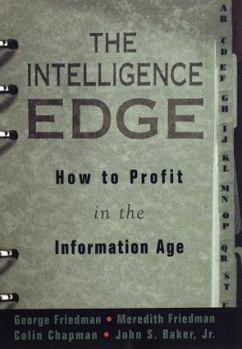The Intelligence Edge: How to Profit in the Information Age
Select Format
Select Condition 
Book Overview
Knowledge is power, and today's age of information calls for new ways of attaining and controlling knowledge. Your business can get an edge over its competitors by being able to find essential... This description may be from another edition of this product.
Format:Hardcover
Language:English
ISBN:0609600753
ISBN13:9780609600757
Release Date:October 1997
Publisher:Crown Business
Length:276 Pages
Weight:0.45 lbs.
Dimensions:1.0" x 6.5" x 9.3"
Customer Reviews
2 ratings
Outstanding Resource and Reference Book
Published by Thriftbooks.com User , 25 years ago
As an investment banking anaylst, one of my primary jobs is build financial models of the companies we evaluate. One of the most underrated and (in my view) more important element of my work comes when we perform due diligence and understand the soundness of the assumptions we build into our models. Most analysts (in my experience) are too infatuated with their sophisticated spreadsheets and believe the sheer complexity of their models can compensate for a lack of understanding of the fundamental business they are set to evaluate. The book does an outstanding job of articulating, at every step, the importance of challenging one's assumptions and systematically gathering, synthesizing, and =analyzing= information that helps to dig through the colored lenses of wishful thinking or purely numerical analysis. The occasional injection of humor is quite welcome - in a world of stuffy self-important books on business, here's a piece of work that was written by people who love what they do, and are adept at making you better at what you do as well.
Excellent Book for REAL Practitioners in the Art
Published by Thriftbooks.com User , 25 years ago
I work as a professional performing due diligence for VC firms and client companies in Seattle and Silicon Valley. I have been using many of the techniques for several years that enable me to rapidly assess business opportunities and develop turnaround strategies. I am also a member of the Society of Competitive Intelligence Professionals.What this book did was enable me to enhance my business process and better articulate this extremely difficult line of work. For example, the business process outlined on page 58 is crucial in that it identifies several "Stop" or check points with clients. Key in this type of consulting, especially where steps you take as a consultant may directly add risk to your client, it is important to know where to draw the line and involve them for a decision. The authors clarify where the key decision points are when it comes to going from passive to semi-active, to active intelligence gathering. Critical, as time is money to you. But! to the client, information - or exposure thereof also means risk that could become your liability.Consultants in this field are in the knowledge business, and one of the most difficult things to do is get the client to place a value on knowledge or intelligence. The authors, through wit and excellent real-world examples, spell out some of the keys to getting paid!! (pp 67). Naturally, this would go over the head of the casual reader who has never practiced and is looking for a "cook book" approach to due diligence of new business opportunities (i.e. see above commentary from Bogota).This book is a "how to" book in that the authors have taken the time to clarify and rank several research tools and locations that one might not normally be aware of. This comparison alone is worth the money, as anyone who has used the web for performing research would agree.The real brilliance in this book is subtle. By connecting the examples, you learn how to ask questions and iden! tify with what is important in doing intelligence research.! Again, for anyone who has gone in circles with clients who "don't know what they don't know", or worse yet, don't know how to value knowledge - this is critical to delivering fast, and minimizing your exposure. Frankly, the Bogota guy didn't get it and has probably never performed true business intelligence. I agree that the coverage of the Internet web search engines, which used the example of finding information on pagers, is old news. The chapter's purpose was to show how more advanced tools outside of the Internet, such as Nexis, are preferred substitutes. That point was clearly made. However, this example was only used among 10 pages of chapter 5 (which was taken up with images of why the web doesn't work). The other 257 pp of this book are the meat. My hats off to the authors for delivering a humorous text based on real-world wisdom that cuts through a very gray area that is as difficult to perform, as it is to explain.





